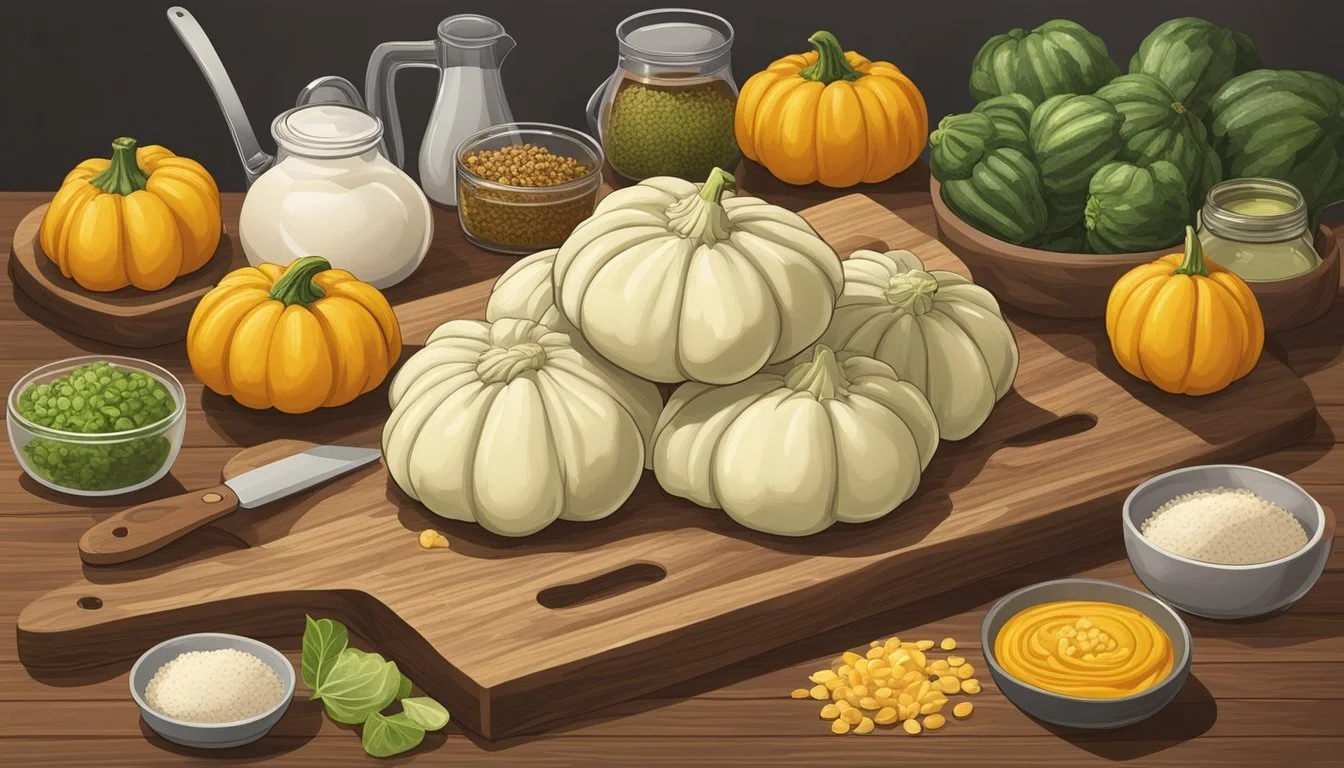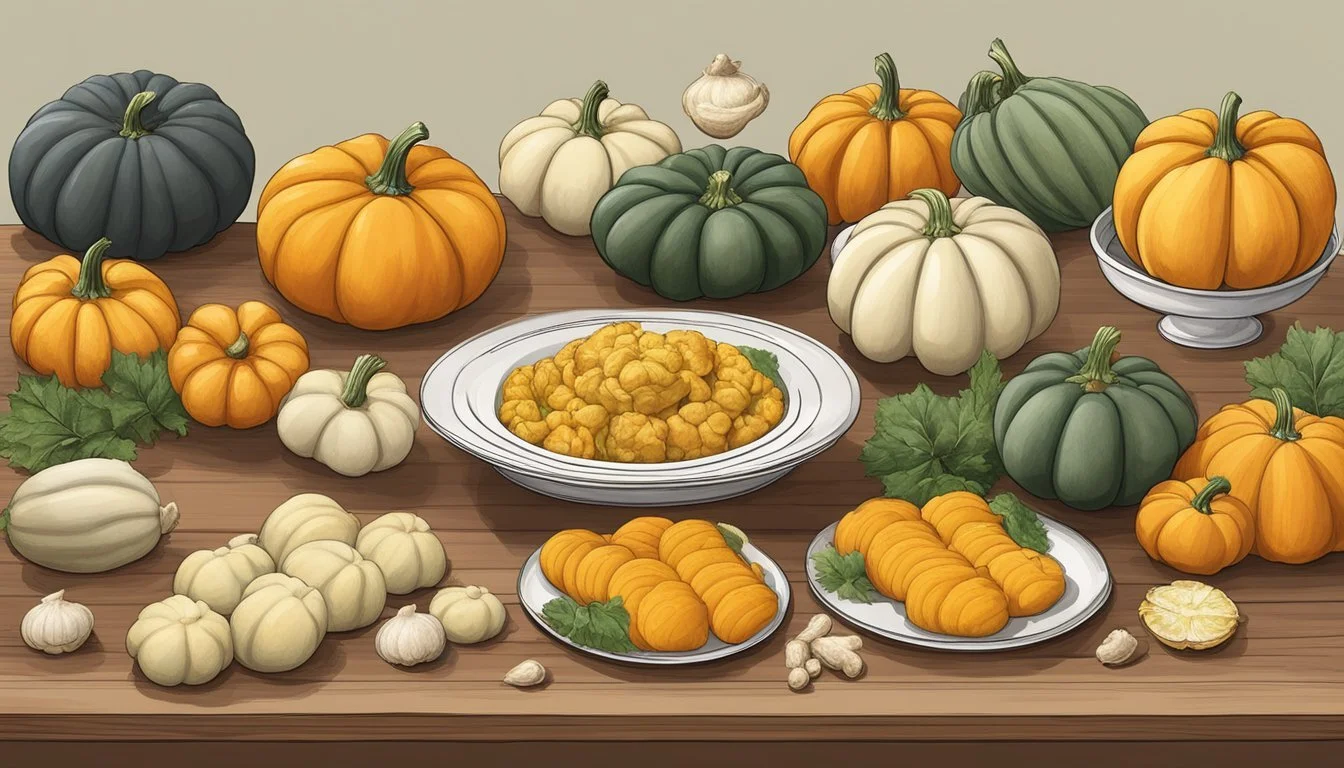Sweet Dumpling Squash Substitutes
Top Alternatives for Your Recipes
For those who love the sweet and nutty flavor of sweet dumpling squash but can't find it, there are several excellent substitutes available. Butternut squash is one of the best alternatives, as it shares a similar sweetness and can be used in various dishes such as soups, stews, and roasted preparations.
Another notable substitute is sweet potatoes. They offer a comparable texture and vibrant color, making them suitable for recipes that typically call for sweet dumpling squash. Additionally, sweet potatoes can be easily found in many grocery stores throughout the year.
For a more adventurous option, consider sugar pumpkins. With their slightly sweet taste and tender flesh, sugar pumpkins can mimic the qualities of sweet dumpling squash well in recipes. These versatile swaps ensure that delicious, nutritious meals can be prepared even when sweet dumpling squash is unavailable.
Sweet Dumpling Squash Overview
Sweet dumpling squash is known for its unique shape, creamy color with green stripes, sweet flavor, and various culinary applications. It is a winter squash with edible skin and rich nutritional benefits.
Understanding Sweet Dumpling Squash
Sweet dumpling squash is a type of winter squash characterized by its small, pumpkin-like shape. Each squash is about the size of a large apple and typically weighs under one pound. The skin is cream-colored with distinctive green and yellow stripes, and the flesh inside is bright orange. The flavor is sweet and slightly nutty, making it an excellent choice for roasting, stuffing, and baking. The skin, although tough, is edible once cooked, adding an extra layer of texture.
Nutritional Profile
Sweet dumpling squash is not just delicious; it is also packed with nutrients. It is an excellent source of Vitamin A and Vitamin C, key antioxidants that support immune health and vision. The squash also contains fiber, which aids in digestion, and potassium, which is essential for maintaining cardiovascular health. Additionally, it offers B vitamins and iron, contributing to overall metabolic and energy functions. Low in calories, with about 47 calories per 100 grams, it fits well into a healthy diet.
Culinary Uses
Sweet dumpling squash is highly versatile in the kitchen. Its natural sweetness and tender texture make it perfect for various cooking methods. It can be sliced, seasoned, and roasted or baked whole and stuffed with grains, meats, or vegetables. Its flesh can be pureed into soups or added to casseroles. This squash pairs well with flavors like maple syrup, cinnamon, and nutmeg, enhancing its sweet profile. Seeds from the squash can be roasted as a nutritious snack. Additionally, the edible skin adds an appealing texture whether it’s baked or fried.
Selecting and Storing
Selecting and storing sweet dumpling squash properly ensures you get the most flavor and longevity from this delightful winter squash. Pay attention to its size, skin, and color when choosing, and store it in the right conditions to maintain freshness.
How to Choose the Best Sweet Dumpling Squash
When selecting sweet dumpling squash, pick those that are firm and heavy for their size. The skin should be hard and free of soft spots or blemishes. Ideal size is usually 4-5 inches in diameter. Look for vibrant, creamy white skin with green, orange, or yellow stripes.
Check the stem, which should be dry and firm. The hardness and weight indicate a mature squash that will be sweet and flavorful.
Proper Storage Techniques
Store sweet dumpling squash in a cool, dry place such as a cellar or pantry. The ideal temperature is between 50-55°F. Keep them away from direct sunlight and moisture to prevent mold and rotting.
Ensure good air circulation around each squash by not stacking them closely. If stored properly, sweet dumpling squash can last for up to 3-4 months.
Refrigeration is not necessary unless the squash is cut. In that case, wrap the pieces in plastic wrap or place them in an airtight container and store in the refrigerator for up to a week.
Preparing Sweet Dumpling Squash
Sweet dumpling squash is versatile and can be cooked in various ways, making it easy to incorporate into different recipes. Proper cutting and peeling techniques ensure that you safely and efficiently prepare the squash for cooking.
Ways to Cook
Sweet dumpling squash can be roasted, baked, steamed, or microwaved. Roasting is a popular method that brings out its natural sweetness. Preheat the oven to 425°F, slice the squash into wedges, and toss with olive oil, salt, and pepper. Roast for 30-35 minutes until golden brown and tender.
Baking is another option. Halve the squash, remove the seeds, and place cut-side down on a baking sheet lined with parchment paper. Bake at 400°F for 35-40 minutes until tender. This method is great for making soups and purees.
Steaming is quicker and retains more nutrients. Cut the squash into chunks and steam for about 15-20 minutes until soft. Another quick method is microwaving. Pierce the squash with a fork, place it in the microwave, and cook on high for 10-12 minutes, or until tender.
Tips for Cutting and Peeling
Cutting and peeling sweet dumpling squash may seem daunting, but with the right approach, it becomes manageable. Start by washing the squash thoroughly to remove any dirt. Use a sharp, sturdy knife to slice off the top and bottom ends, providing a stable base.
To halve the squash, place it on a cutting board and carefully slice it down the middle. Scoop out the seeds with a spoon. If peeling is necessary, a vegetable peeler works well due to the squash's relatively thin skin.
For dishes where the skin is not desired, it’s often easier to peel after the squash has been cooked. Simply separate the flesh from the skin with a spoon after roasting or baking. Handling carefully and using proper techniques ensure a safe and efficient preparation process.
Sweet Dumpling Squash Substitutes
When looking for substitutes for sweet dumpling squash, consider the texture, flavor, and utility in various recipes. Here’s how different squash varieties and other substitutes can match sweet dumpling squash effectively.
Substituting Based on Texture
For a similar texture, acorn squash and delicata squash are excellent choices. Acorn squash has a firm and slightly dry texture, which aligns well with that of sweet dumpling squash. Delicata squash offers a similarly tender texture, making it a good fit for most recipes.
Kabocha squash, with its dense and dry flesh, can also work when texture is critical. Spaghetti squash, on the other hand, lacks the dense texture but can be useful in recipes that accommodate its unique, stringy consistency.
Flavor Matching Substitutes
To match the distinctive sweetness of sweet dumpling squash, butternut squash and pumpkin are the best substitutes. Butternut squash has a creamy, sweet flavor that closely resembles the sweetness of sweet dumpling squash.
Pumpkin, especially sugar pie varieties, provides a mildly sweet taste and soft texture, making it a good match in both savory and sweet dishes. Delicata squash can also offer a similar level of sweetness, enhancing dishes without overpowering other ingredients.
Substitutes for Structural Uses
For recipes that require the squash to hold its shape, such as stuffed squash dishes, acorn squash and kabocha squash are the most fitting substitutes. Acorn squash maintains its structure well when baked or roasted, making it ideal for stuffing.
Kabocha squash, with its sturdy exterior, also excels in recipes requiring the squash to act as a vessel. Butternut squash halves can sometimes be used as a substitute, though they may require more support to hold fillings effectively compared to the sturdier structure of sweet dumpling or acorn squash.
Substitute Sweet Dumpling Squash in Recipes
When substituting sweet dumpling squash, consider alternatives that match its sweet and tender characteristics. Each substitute brings unique qualities that can shine in various recipes like soups, stews, baked goods, side dishes, and main courses.
Soups and Stews
For soups and stews, butternut squash and kabocha squash are excellent substitutes.
Both have a smooth texture and a natural sweetness that integrates well into broths and creamy bases.
Kabocha's nutty flavor enhances curries and stews, creating a complex profile.
Butternut squash, with its vibrant orange color, adds a rich, buttery taste.
For a different texture, sweet potatoes can also work, imparting a distinct mild flavor while maintaining the creamy consistency when pureed.
Baked Goods and Desserts
In baked goods and desserts, substitutes like pumpkin or acorn squash can be used.
Pumpkin puree is a common choice for pies and muffins, providing a smooth texture and sweet taste similar to sweet dumpling squash.
Acorn squash pairs well with spices in bread and cookies, offering a similar sweet profile with a slightly firmer texture.
For cakes and pastries, buttercup squash can be an excellent choice, maintaining moisture while introducing a subtle sweetness.
Side Dishes and Salads
For side dishes and salads, delicata squash and hubbard squash are good alternatives.
Delicata squash, with its edible skin, simplifies preparation and adds a slight sweetness that complements roasted vegetable medleys or warm grain salads.
Hubbard squash, with its dense flesh, works well when cubed and roasted, mixed with greens, or added to cold pasta salads for a touch of sweetness and texture.
Using these substitutions ensures similar nutritional values and taste profiles, adapting well with various herbs and dressings.
Main Courses
In main courses, spaghetti squash and butternut squash can effectively replace sweet dumpling squash.
Spaghetti squash offers a unique texture perfect for pasta dishes or casseroles, pairing well with tomato-based or creamy sauces.
Butternut squash can be roasted or mashed as a side to meats or stuffed with grains and vegetables for vegetarian main courses, balancing flavors with its richness and sweetness.
These substitutions provide versatility while maintaining the essential qualities of sweet dumpling squash in hearty dishes.
Health Considerations
Sweet dumpling squash is not only flavorful but also packed with essential nutrients. This section explores its health benefits and addresses dietary restrictions and common allergies associated with it.
Benefits of Sweet Dumpling Squash
Sweet dumpling squash offers a multitude of health advantages. It's high in vitamins A and C, which are vital for immune function, skin health, and vision. Additionally, it provides minerals like calcium and iron, important for bone health and oxygen transport.
The squash is low in calories but high in fiber, contributing to digestive health and maintaining a healthy weight. It includes moderate amounts of protein, making it a well-rounded option for various diets. Its natural sweetness also makes it a healthy alternative to sugary foods.
Dietary Restrictions and Allergies
Those with specific dietary needs or allergies should take certain precautions when consuming sweet dumpling squash. While it's generally considered a healthy option, individuals with allergies to gourds or pumpkins should avoid it, as it might trigger allergic reactions.
People with specific carbohydrate sensitivities might need to monitor their intake. For those on low-carb diets, it's essential to consider the carbohydrate content in sweet dumpling squash. Despite these concerns, sweet dumpling squash fits well into many healthy eating plans, given its low calorie count and nutrient density.







